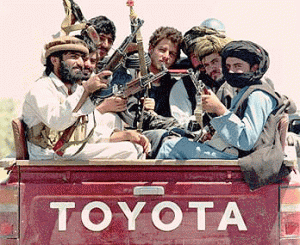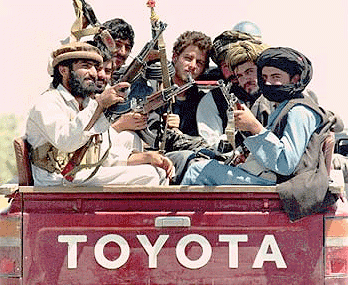 Imagine playing a game in which your opponent always has the last move. Or can undo your last move if he chooses. How much fun would that be, and how long would it take you to decide that it wasn’t worth playing?
Imagine playing a game in which your opponent always has the last move. Or can undo your last move if he chooses. How much fun would that be, and how long would it take you to decide that it wasn’t worth playing?
For most any hominid with a cranial capacity over 750 cc, the answer would be, not very long. For the US government in Afghanistan, it’s coming up on a decade. And as Pete Seeger put it so well, ‘We were neck deep in the Big Muddy, and the big fool said to push on.’
Not only is that really lousy policy, it’s really bad science.
There’s an axiom in the systems world called the ‘the Law of Requisite Variety’ (AKA The First Law of Cybernetics). It states, ‘The unit within the system with the most behavioral responses available to it controls the system.’
What that means is that an individual or group with more available options – which includes the ability to recognize and act on those options – is most likely to prevail. Because it can more rapidly ‘co-evolve’ within a fluid environment, it can more effectively shape the landscape of the contest, and determine the rules of engagement.
In Afghanistan, the Taliban clearly have more behavioral responses than the American-led coalition. As Mao detailed in ‘insurgency 101’, when the enemy attacks, the Talib retreat. When the enemy stands still, they harass. When the enemy retreats, they pursue.
The Talib – and assorted other aligned and non-aligned groups who see the foreigners as invaders to be expelled – have many options. They can fight. They can flee. They can blend into the population. They can even get day jobs with some of the vast pool of ‘development’ money flowing from the invaders. They can deal opium, control smuggling, charge protection money, and gain loyalty by offering services like a responsive justice system.
The Talib also have home field advantage, and are unconstrained by ‘overprescribed’ rules and hierarchy. They are patient, and can afford to play almost indefinitely. They are highly resilient, relatively inured to hardship, and are largely self-organizing and, therefore, highly and quickly adaptive.
Now, they have effectively identified the key leverage point in the evolving conflict and moved to attack it. That leverage point is the capacity of the Afghan Army and National Police, because America can’t ‘stand down’ if the ANA / ANP can’t ‘stand up’.
And they can’t.
Despite years of prodding, training, funding and arming from the US and her allies, the ANA and ANP are net liabilities, not assets. And Taliban attacks on those institutions are eroding them further. (It’s hard to imagine how much worse the ANA / ANP can actually get. Bogus unit strength rosters and mass desertions are common, and some units have apparently sold or given their arms to insurgents.)
And the American reaction?
A ‘strategy’ that can best be described as wishful thinking from ‘the WABAC Machine, Sherwood’.
Seemingly right out of Westy Westmoreland’s playbook, the American ‘plan’ is to ‘degrade’ the Taliban in the same way America intended to win in Viet Nam by ‘atritting’ the Viet Cong / NVA. And to save villages by destroying them, in order to win ‘hearts and minds’
Oh, and apply a bit of good old WWI thinking to take and hold ground.
Aieee, Bro! Pass the Prozac!
Do all those shiny stars on starched collars cut off blood flow to the brain? (Is this why nearly everyone above the rank of company officer seems to be a flatliner?)
1. You can’t degrade / atrit the other team in a ‘protracted popular war’, especially when the enemy is ‘tribals’. (Read FM 3-24, the COIN manual co-authored by Gen David Petraeus, to better understand why that strategy is brain dead.) Not only do they have an infinitely deeper bench, for every one you ‘degrade’, a brother or cousin or friend (or all the above) will pick up their fallen comrade’s weapons and swear a blood oath of vengeance.
2. In a ‘population-centric’ conflict, destroying villages (and villagers’ already tenuous livelihoods) turns them into the enemy – not away from them. Can anyone recall a resident of a ‘strategic hamlet’ in Viet Nam who was filled with love and loyalty to the government and their US backers after being forcibly expelled from their traditional homes and separated from the graves of their ancestors?
3. Taking and holding ground is not only not a metric of success in a counterinsurgency campaign – it’s an admission of failure! It means you’re reacting to the enemy’s initiative, and he’s tied up your forces. If you’re going to play that game, you have to have the force levels to do it, and the US simply cannot provide those. (As noted in a previous post, that would be over 1.4 million troops, based on the classic density ratio of 20 counterinsurgents per 1,000 population. And, as detailed above, the ANA / ANP are so bad they would have to be subtracted from that total, not added it.)
The COIN manual offers another important observation that senior US leadership seems to have missed. ‘Without good intelligence, a counterinsurgent is like a blind boxer, wasting energy flailing at an unseen opponent and perhaps causing unintended harm.’
How prophetic.

